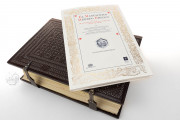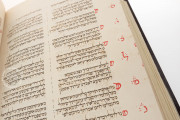The manuscript G.II.8 in the Real Biblioteca del Monasterio de San Lorenzo, El Escorial, is a notable specimen of a Hebrew Bible. The codex, crafted on vellum parchment, features double columns of exquisite square Spanish lettering with Tiberian vocalization. Richly ornamented with filigree, calligraphic medallions, and labyrinthine designs, the manuscript dates to the fifteenth century and bears a Mudéjar binding. It comprises 386 folios within a frame of 27.5 by 20 cm and boasts a unique blend of artistic and textual elements.
Elaborate Filigree and Calligraphic Embellishments
The context of Manuscript G.II.8 unfolds within the vibrant tapestry of fifteenth-century religious and scriptural exploration. Its materiality, characterized by avitelado vellum, invites readers into a visually stunning presentation. Noteworthy features include meticulous punctuations and masoras in the Pentateuch, excluding Genesis 17:26-25 and 19. The manuscript stands out for its elaborate filigree and calligraphic embellishments, evoking the artistic spirit of its time.
Elegant Script
The script employed in Manuscript G.II.8 is a testament to the calligraphic finesse of its scribe. The square Spanish lettering exudes a captivating elegance. The style seamlessly integrates with the visual richness of the manuscript, creating a harmonious marriage of form and content.
Copied by a Single Scribe
The unity of the script throughout the entire biblical text suggests a single hand behind the manuscript's creation. While variations exist in the writing style for corrections and annotations, the overall coherence of the script reinforces the notion of a single origin. Notably, marginal notes and corrections by different hands, such as those in Nurn 28:25 and Canticles 5:12, provide glimpses into the evolving usage and adaptations of the manuscript over time.
Later annotations with letters or numbers point to the possibility that this manuscript – together with other codices also housed in El Escorial and the Library of the Complutense University of Madrid – was used for the correction of the Hebrew text of the Complutense Polyglot Bible commissioned by Cardenal Cisneros at the beginning of the sixteenth century. In fact, in the copy there are glossed notes and corrections of the text made in the margin in red ink that indicate the beginning of the chapters and which possibly correspond to the work carried out by Alfonso de Zamora for the Cisneros Bible.
Dating the Manuscript
The absence of a colophon or date necessitated the use of paleographic methods for dating, placing Manuscript G.II.8 firmly within the fifteenth century. Despite the lack of specific historical markers, the manuscript's journey is discerned through the nuanced exploration of its parchment, script, and binding.
We have 1 facsimile edition of the manuscript "Escorial Hebrew Bible": Biblia Hebrea facsimile edition, published by Testimonio Compañía Editorial, 1997
Request Info / Price



























